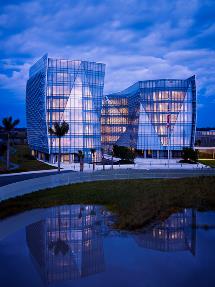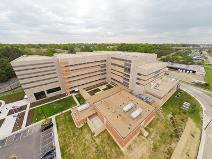Over the months leading to our annual Design-Build Conference & Expo, hosted this year in Denver Colorado from November 2-4, we have been posting weekly projects that have earned the distinction as a 2015 DBIA Merit Award winner. These projects, at a minimum, resulted in highly successful delivery and achieved best value while meeting design and construction quality, cost and schedule goals. These projects will also be highlighted during the Design-Build Conference & Expo on November 3 during an Awards Reception. Please join us by registering for the conference here. This week we recognize the winners from our Federal, County, State Municipal Category.
 Benjamin P. Grogan and Jerry L. Dove Federal Building
Benjamin P. Grogan and Jerry L. Dove Federal Building
Challenge Design-Build Project Delivery Addressed:
The GSA sought a facility that met their P-100 guidelines, performance specifications and the FBI’s Program of Requirements (POR) and achieved occupancy by December 2014. Despite a request to complete various changes and additions for the electrical and communication components, which was estimated to add four months to the project, design-build allowed Hensel Phelps to work closely with the owner and furniture vendor to facilitate the manufacturing of the systems and shorten lead times. This achievement allowed the team to meet the original final completion date.
Summary:
This was a bridging design-build project consisting of four buildings in a campus environment located near the Everglades. This project was designed and built to be LEED Platinum Core and Shell (C&S) certified, LEED Gold Commercial Interiors (CI) certified and Sustainable Sites Initiative (SSI) Two Star certified. Totaling 383,000 square feet, the project includes enhanced security specifications, an enclosed parking structure and multiple buildings on the 20-acre site. The GSA required a facility that met the Level 4 Interagency Security Committee criteria. The 303,552 square feet combined, six- and seven-story office towers are connected by a six-story link and include executive office spaces, private offices, team office spaces, conference space, storage, a fitness center, computer training, treatment rooms, workrooms and an armory.
John M. Roll United States Courthouse
Challenge Design-Build Project Delivery Addressed:
At the time, GSA was “testing” the design-build delivery method for this program type (it was one of three Courthouses being built).
Summary:
The John M. Roll Federal Courthouse sustainably reinterprets and updates classical American courthouse design for the community of Yuma, Arizona. The LEED Gold (pending) 60,000-square-foot building won a design-build competition sponsored by the General Services Administration (GSA) Design Excellence Program. The uniqueness of this new justice facility located on the U.S.– Mexico border demanded a variety of design solutions tailored to its unusual program. John Roll, the state’s chief federal judge, declared a judicial emergency and was an energetic advocate of the building’s design. Following Judge Roll’s death in the 2010 slayings that also gravely injured Congresswoman Gabby Giffords, President Obama signed into law a measure naming the new courthouse after him. The courthouse’s primary purpose is to process defendants en masse in a safe, speedy and humane manner, while also offering a welcoming landmark to the citizens of Yuma.
Challenge Design-Build Project Delivery Addressed:
One of the biggest challenges for the owner was the ability to maneuver to other options once design and construction began. This was directly addressed by implementing a GMP (Guaranteed Maximum Price) contract and ensuring that the owner’s program manager had funding set aside in a contingency fund. These provisions allowed the owner to set aside funds and keep doors open that would normally have been closed after the design phase.
Additionally, as the facility was a jail, the risks of constructing a new facility on a new site outweighed the challenges of constructing on the existing site. As a result, the parties involved had less space to operate and increased safety concerns. Just-in-time delivery practices were used in order to keep the project flowing without having a lay-down area for materials. For example, the precast structure of the building had a minute by minute delivery and erection schedule created and adhered to by the contractors.
Summary:
The Richmond Justice Center was a project more than 20 years in the making. Replacing a facility built in the 1960’s that was approximately half the size of the new 412,000-SF center, the new Justice Center offers air-conditioned spaces for inmates and staff, medical and dental clinics and dedicated staff accommodations, including locker rooms, a fitness area and dining areas — all features that were lacking in the prior facility. Inmates that were previously housed in a communal enclosure surrounded by bars (sometimes up to 150 men at a time) are now housed in pods containing no more than 45 individual cells. These pods contain a day room, eating facilities and an exercise room, eliminating the need for inmate transport throughout the facility and providing a more secure environment for residents and staff.
Social Security Administration National Support Center
Challenge Design-Build Project Delivery Addressed:
GSA chose a design-build delivery approach to minimize risks related to design and construction coordination by having a single point of accountability for both components.
Summary:
The Shockey Companies worked collaboratively with the General Services Administration (GSA), Social Security Administration (SSA) and JACOBS throughout the design and construction of the new National Support Center (NSC) to create a state-of-the-art facility with a commitment to innovation, sustainability and the stewardship of resources. The 300,000-squre-foot facility, located in Urbana, Maryland, is comprised of a Data Center, Office Building, Facility Access Center, Warehouse, Service Yard and Energy Center and replaces the existing National Computer Center (NCC). The NCC facility had been plagued by an inadequate heating and cooling system, as well as an electrical system so old that spare parts are no longer available. Failure of these systems had the potential to shut down the NCC that houses 450 million earning records and benefit data for almost 56 million beneficiaries. The NSC project was of critical importance to the daily operations of our federal government and was deemed as one of highest priorities funded out of the 2009 American Recovery and Reinvestment Act.



